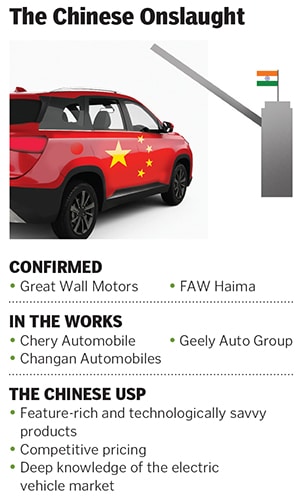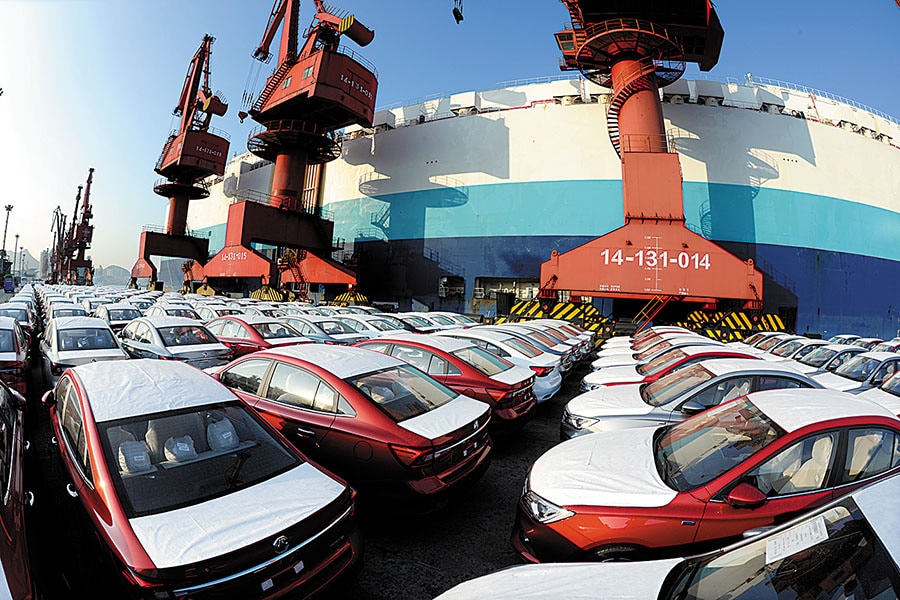China drives into India
With India showing the potential to become the third-largest automobile market in the world, car makers from China are revving up to sell their vehicles here


 China"s Great Wall Motors has lined up investments worth Rs 7,500 crore for IndiaImage: Sergei Bobylev / Tass via Getty Images
China"s Great Wall Motors has lined up investments worth Rs 7,500 crore for IndiaImage: Sergei Bobylev / Tass via Getty Images
A Chinese storm is approaching India’s automobile sector and it has the potential to change its landscape forever.
The automobile industry in India is dominated by homegrown automobile manufacturers in addition to Korean and Japanese brands. However, at the Auto Expo this year, two of China’s biggest carmakers—Great Wall Motors (GWM) and FAW Haima—announced their intention to sell vehicles in India, across segments, entering into even the fledgling electric vehicle (EV) market. Many more are planning a similar foray into the world’s fourth-largest automobile industry.
GWM, China’s largest sports vehicle manufacturer, showcased its Haval range of SUVs at the Auto Expo, in addition to the GWM EV. FAW Haima showcased the FAW Haima 8S and 7X SUVs, and has firmed up plans with Delhi-based Bird Group to launch an EV priced at less than Rs 10 lakh. In all, Chinese carmakers exhibited more than 20 models at the Auto Expo.
Shanghai-headquartered SAIC Motor has already been selling MG cars in India since last year. Changan Automobiles, a car maker owned by the China government, is also likely to begin operations in India by 2022, apart from other companies like Chery Automobile based in Wuhu and the Geely Auto Group from Hong Kong.
Their planned entry comes at a time when India’s automobile sales declined by 16 percent between April 2019 and February 2020. China also saw its market shrink, with vehicle sales falling by over 8 percent in 2019, forcing companies to look outside the world’s second-largest automobile market, which is behind only the US.
“India is expected to be the third-largest automotive market [overtaking Japan] by 2025 and it is a critical part of Great Wall Motors’ globalisation strategy,” Hardeep Singh Brar, director, marketing and sales, Great Wall Motors, tells Forbes India. “India is undoubtedly one of the most promising auto markets in the world. For foreign investors, the favourable investment environment in India enables it to be their preferred destination for direct investment,” he says, explaining that the Baoding-headquartered company has been paying attention to and studying India “with an objective of executing investment plans”.
According to government think-tank Niti Aayog, only 22 out of 1,000 people own a car in India [compared to 980 in the US and 850 in the UK]. The increasing number of first-time users enhance India’s potential to become the world’s third-largest automobile industry over the next few years.
The government push toward electric mobility through policy changes has also opened avenues for Chinese manufacturers to tap into the Indian market. Apart from reducing GST on EVs from 12 percent to 5 percent last year, the government has provided an income tax deduction of Rs 1.5 lakh on interest paid on loans taken to buy EVs. It has also approved the setting up of 2,636 EV charging stations across 62 cities under the second phase of its FAME scheme.
GWM has lined up investments worth $1 billion (Rs 7,500 crore) for India and purchased General Motors’ manufacturing facility in Talegaon near Pune in January for an estimated $250 million (Rs 1,800 crore). “SUVs are growing at a much faster pace than the rest of the segments and contribute more than 25 percent to the overall market [in India],” adds Brar.
“GWM’s Haval is the number one SUV brand in China... and with the growth in the SUV segment, we feel this is the right time to enter India,” he says. “GWM started as early as 2016 when we launched our R&D centre in Bengaluru... now we will be setting our manufacturing facility in India.”
Lining up
India’s automobile industry is dominated by Maruti Suzuki, which controls nearly 50 percent of the market. Hyundai has 20 percent market share followed by others such as Kia Motors, Tata Motors and Mahindra. At the same time, many global car manufacturers, including Nissan [Japanese], Renault [French] and Volkswagen [German], haven’t been able to find much success in India in recent times.
Much of the interest from Chinese auto makers—particularly at a time when American and European car makers are struggling to make inroads in India—comes at a time when SAIC-owned MG Motor India demonstrated the potential of the Indian market for Chinese companies. Since it set up operations here last June, the company has garnered over 50,000 bookings for its wildly popular SUV, Hector, with MG Motor India delivering some 3,000 units every month. At the Auto Expo, the company displayed 14 models.
“Today, the Indian consumer does not care about the country of origin of a vehicle,” says Rajeev Chaba, president and managing director, MG Motor India. “They believe in value for money and are happy as long as their needs are fulfilled. Besides, the automobile industry is a global one, with parts being sourced from many places, and therefore a company isn’t specific to one region alone. Besides, having Chinese resources offer the best proposition.”
In 2017, MG Motor India had taken over a manufacturing facility previously owned by General Motors in Halol, Gujarat, after the American car maker decided to call it quits in the Indian market due to floundering sales. The company spent over `2,200 crore on the acquisition of the facility and expanding its capacity. Shanghai-headquartered SAIC Motor has been selling MG cars in India since last year
Shanghai-headquartered SAIC Motor has been selling MG cars in India since last year
Image: Wang Chun / VCG vis getty Images
“For many global companies, India was just another market,” says Vinay Piparsania, former executive director at Ford India, and consulting director–automotive at Counterpoint Technology Market Research. “Chinese companies, however, hadn’t gone out of their own country and India is only one of the few markets that they are foraying into. With their resources, focus and the potential that the Indian market offers, the Indian automobile landscape is in for some big churn.”
“Essentially, two companies dominate the Indian market,” adds Piparsania, referring to Maruti Suzuki and Hyundai. “While there are challenges as far as perception goes, the success of MG Motor gives confidence to others as long as they can offer a feature-rich product and the right quality. He explains that the situation is somewhat similar to the mobile phone market in India, which was once dominated by domestic manufacturers and South Korean brands before the onslaught of Chinese smartphones led by Xiaomi, Vivo and Oppo.
The ongoing slowdown hasn’t deterred companies from firming up their India plan because the market is expected to bounce back later this year. “We have been evaluating the market for a long time and are in the process of finalising the products, location and segments,” says an executive involved in the launch of a Chinese auto maker. “The market will bounce back and there is a massive opportunity there. In 1998, nobody knew about Korean brands in India and today they are the second-biggest in India. There is a similar story waiting for the Chinese brands because the consumer is looking for the best value proposition, which these companies can offer.”
Chinese companies are taking advantage of the cost consciousness of the Indian market as the domestic automobile industry undergoes a transformation. “The Indian automobile market is getting expensive, so much so that even Maruti Suzuki is becoming more expensive,” says Puneet Gupta, associate director for automotive forecasting at IHS Markit. “With their deep pockets and innovative offerings, the Chinese players will be able to offer great features and style to consumers. Time and again, Indian consumers have shifted priorities and they aren’t loyal to one brand.”
EV potential
The Chinese auto makers are also bringing to India their vast experience in the EV segment. China is the world’s largest EV market, accounting for one out of two EVs sold globally. In January, MG Motor India launched its first EV for the Indian market, an SUV named MG ZS EV, priced at around Rs 23 lakh it has received over 3,000 bookings so far. The vehicle has a range of 340 km.
“Electric vehicles will be an integral part of our strategy,” says Brar of GWM. “It’s because GWM is quite strong in EVs in China. Also, there is a lot of thrust by the Indian government on EVs. Hence, GWM would like to use its expertise and be part of the growth story for EVs in India. We are exploring all forms of EVs at this stage, which include pure EVs, hybrid EVs, and plug-in hybrid EVs.”
In February, Haima Automobile announced a joint venture with Bird Group to launch an electric hatchback, with range options of 200-300 km. The vehicle will be manufactured at a soon-to-be-set-up plant in Manesar in New Delhi.
“With the world moving towards clean mobility with least environmental impact, we are satisfied with the Bird Electric EV1,” Williams Dong, general manager, Haima Automobile International Corporation, said during the launch. “We have entered the fastest-growing segment of the Indian automobile… Bird Electric EV1 will reinvent the game in terms of technology and economy, targeted at a wide set of customers across segments.”
The gamble on the EV market could reap rich rewards, considering the government has been pushing for more EVs and is investing in creating the required infrastructure.
“Until a few years ago, we had not even heard about electric rickshaws,” says Kanv Garg, director for renewables and electric mobility at consultancy firm EY. “The kits came from China and the market grew organically even without government support. Customers only care about high quality and minimum cost and with the Indian companies being in an inertia as far as EVs are concerned the Chinese have a huge potential.”
It isn’t just car makers who are making a beeline for the Indian market. The two-wheeler market, currently dominated by motorcycles, could also see some serious threat from Chinese companies. Already, Chinese electric two-wheeler maker DAO EVTech has announced plans to set up a manufacturing unit in Andhra Pradesh, while Benling and CFMoto are gearing up to launch electric bikes in India.
Then there are truck and bus manufacturers, including Sinotruk and Foton, which have been operating in India since 2011. Beiqi Foton has tied up with Haryana-based PMI Electro Mobility Solutions Pvt Ltd for manufacturing electric buses, while the $20-billion Shenzhen-based manufacturer BYD Co Limited has a partnership with Hyderabad-based Olectra Electric to supply electric buses for various state governments.
“In many ways, MG Motor has given Chinese car makers the confidence that they will be able to find success in India,” says Gupta of HIS Markit. “What matters is features and style... and the Chinese have been extremely competitive and innovative in that space.”
Brar of GWM agrees. “GWM will bring in technology disruptions in terms of products that the Indian consumer has so far not seen and experienced,” he says. “We will make a bold foray in India to place ourselves as a premium brand, offering the best-in-class fit, finish and interior quality, focusing on technology disruption as a target in the near future for an enriching experience for our consumers.”
With the coronavirus crisis in China and across the world, concerns have risen over the supply chain network of Chinese companies. “The foray into India also provides companies with the opportunity to target export-oriented markets,” says Piparsania. “Every player coming in will set up the ecosystem to remain competitive in the Indian market and supply chains should never be a major concern. In addition, companies are also laying groundwork on building a strong dealership and service network.”
“For now, the focus is on getting the products for the Indian market right,” says the executive working with the Chinese auto maker. “Dealers will always be there and sales and service network aren’t a cause of concern.” GWM, too, has laid out plans to set up its network across Tier I, Tier II and a few select Tier III cities to begin with. “We shall look at select but strong partners with a high degree of customer and brand orientation,” adds Brar.
The Chinese onslaught has begun and India’s auto sector could be in for some serious transformation.
First Published: Mar 27, 2020, 11:44
Subscribe Now